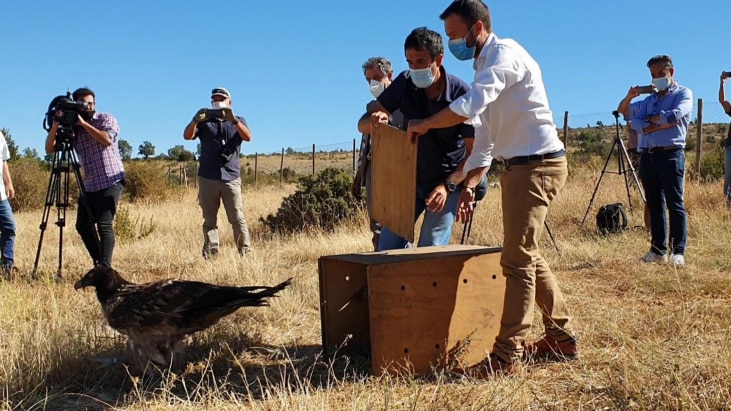The Bearded Vulture and the High Tagus
As every first Saturday of September we have to celebrate the International Vulture DayToday we would like to tell you a story that may mark a before and after in the presence of the king of the skies in the Natural Park of the Alto Tajoand, therefore, in the Serranía de Cuenca.
The presence of a multitude of vultures in these areas is high, but today's story tells of the fate of one of them that has not yet ended up flying over our lands to stay, although we can see that moment getting closer and closer. The bearded vultureThe mastodon that dominates everything from on high is our protagonist.
Presence of the Bearded Vulture throughout history
For many years and possibly until the 1960s-70sWe could see the imperious figure of the bearded vulture travelling through the skies of the Tagus river canyon, numerous testimonies affirm this, and we can even say that it was not unusual for a resident of the villages of the Upper Tagus to know the location of the nests where they bred the coming generations in the more inaccessible cuttings. But as we know, those times are in the past, it has been a long time since these lands have seen the growth of any chick of this species.However, these times of austerity may be coming to an end.
Introduction of the Bearded Vulture in the Upper Tagus
Already in 2005 the first steps were taken in the recovery of the habitat that the bearded vulture once occupied until a recent study qualified the environment of the Alto Tajo Natural Park and the Serranía de Cuenca for their reintroduction.
Both the regional government and the management of the natural park have tried insistently to ensure that this moment arrives as soon as possible. In the first place, the actions are focused on the attraction of young individuals that they find this environment attractive and settle there naturally, and in case this natural introduction does not work, the reintroduction of specimens mainly from the Pyrenees would be used.. These are adults which, due to lack of space, no longer reproduce, and which may find the perfect habitat in the Tagus canyons.
Although they have been many efforts, this project has not borne fruit.There is still a lot of work to be done to consolidate once and for all this marvellous bird in the north of Castilla la Mancha.
Kika the Bearded Vulture, in Peralejos
A few weeks ago, while enjoying the peace and quiet of the spectacular gorge formed by the river "Oceseca", we met some locals from the village of Peralejos de las Truchaswho told us what was the story of the summer.
It was just over a month ago that a "vulture exhausted and malnourished"had crashed into a local rooftop. While he was in mid-flight, neighbours saw him plummet to the ground. He was soon taken to the Guadalajara Wildlife Recovery Centre and we have not heard anything about it until a few days ago, when, to our surprise, the vulture of that summer anecdote is not a griffon, as we had thought, but rather a bearded vulture which goes by the name of Kika.
Kika is an adventurous female bearded vulture from the species' captive breeding programme, released in June 2019 at 90 days of ageThe project is being carried out in Andalusia, specifically in the sierras of Cazorla, Segura and Las Villas.
But Kika has made it clear that she is a "high-flying bird"and has not yet found the right place to settle down.
Kika is now free
Taking advantage of this situation, once recovered Kika has become a synonym of reward for all those who have been working for almost two decades to create a suitable habitat for her species, as we have been able to witness her release on the dunghill The project was designed to build bridges to a possible and prosperous settlement in the locality where it had crashed two months ago.
So, after multiple attempts and interventions to accommodate this bird of prey permanently in the environment of the Alto Tajo and the Cuenca MountainsToday we have to give good news thanks to pure chance, because if it had not appeared in Peralejos de las TruchasIf her accident had taken place far from the population, she would probably not have been found and would have succumbed.
All hopes, in flight
Finally, we only hope and we wish Kika's flight over the Serranía Conquense and the Alto Tajo Natural Park, is not an anecdotal event and that it finds in this marvellous location the ideal place for its settlement and reproduction, opening the doors to the historical recovery of this exceptional scavenger, which until well into the 20th century inhabited a large part of the Iberian Sierras, in which today, timidly, they are once again becoming interested.


